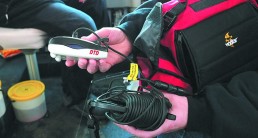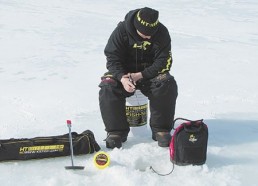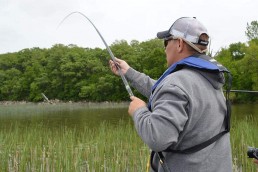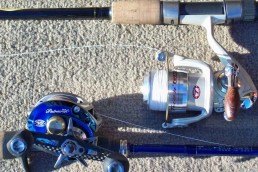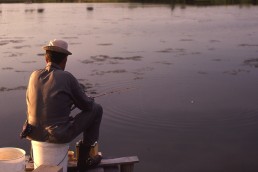‘The Bottom Line’
SHARE THIS POST
“The bottom line” is one of those often overused, mundane phrases with somewhat varied connotations.
When being reprimanded by my mom as a youngster, the common conclusion to a scolding might be: “Bottom line is you shouldn’t have snuck in and fished that pond without the farmer’s permission,” which would be followed by some undesirable form of disciplinary action, such as having my floating Rapalas taken away for a week.
Today, I’m more likely to hear the phrase reiterated at board meetings while reviewing budget allocations, or as part of an ultimatum from my wife when explaining I’ll be late for dinner because I must wait until the farmer returns to his barn before I can leave his pond.
Fortunately, I’ve also discovered the bottom line can also be applied to something very positive: more iced fish.
We’ve all experienced those tentative times, when for whatever myriad of possible reasons, the fish we are jigging nonchalantly approach any number of presentations. You can see this clearly while sight-fishing or monitoring an underwater camera screen. They’ll slowly maneuver within millimeters of the bait and gracefully “fin” in place for an unspecified period of time nearly still before cautiously backing away like an ice angler retreating from a patch of thin ice.
Sure, patiently experimenting with various lures and baits in a wide range of styles and colors set within a plethora of tactical riggings, while implementing the most refined, finesse movements may—if you’re subtle enough—produce a faint nibble or peck by a small fish. But more often than not, the best result is typically little more than your bait being stripped from the hook. Nothing seems to work.
In such situations, moving the presentation in any kind of aggressive, flashy manner often causes fish to immediately dart away. Try working the bait up, and they’ll often simply turn and nonchalantly drift off. Sometimes even holding the bait still receives only casual, disinterested stares.
It can be downright humiliating, yet I’ve found the bottom line in such situations is, well, the bottom line. Rather than trying to work these finicky fish up, I’ll simply begin easing the presentation downward. In tough bite situations, falling presentations often incite noticeably positive reactions. Perhaps such motions trigger an innate response signaling a low-energy feeding opportunity, or the vulnerability of an injured, dying “prey item” fluttering nearby that is too tempting for a fish to pass up.
Whatever it is, I’ve often witnessed the phenomena: Their dorsal fins rise, pectoral fins suddenly begin moving slightly faster, and more often than not, they’ll become more attentive, turn and begin following the bait down. (Often, you can sense something happening as you watch these fish respond to the falling bait.)
This reaction is the basis for incorporating “bottom line” methods. However, making this tactic work consistently in its purest form requires first-hand observation. The best results come either when sight-fishing or using an underwater camera.
Tackle? If fishing panfish, start with a small-profile lure you can confidently control. In shallow water, especially around weeds, tiny small-profile micro jigs tipped with plastic tails can be the key to success, because they drift down in such a slow, seductive manner. Find something similar with a little hair dressing, and it will drop even slower—in fact, a tiny bead fly borrowed from fly fishing annals is a great choice.
When fishing deeper or thicker cover, it’s important to stick with smaller profile designs, but you’ll need something heavier to get down and still maintain a sense of feel. This is where tiny tungsten-style jigs excel, particularly those featuring a plastic tail or tied hackle to help slightly repress the fall. Try compromises, like HT’s #14 Tungsten Marmooska gem. Made from 50 percent tungsten and 50 percent crystal, it’s heavy enough to get down efficiently and control, yet descends relatively slowly.
Line choice is also critical. You’ll need a thin diameter selection just to tie these small-eyed micro lures on—preferably a fresh, soft low-memory line that doesn’t coil and hangs straight to ensure a direct connection between your lure and strike indicator.
Which brings us to the next phase of the “bottom line” system—one that must be carefully considered based on how you fish.
Personally, I prefer relatively stiff, solid carbon and very fast-tipped micro rods such as HT’s MAV-24UL Maverick or the PFX-24ULSC Polar Fire Extreme ultralights, featuring smaller stature, lightweight single- footed guides that follow the natural flex of the blank and won’t negatively affect balance. If you prefer, select solid carbon models fitted with a spring. Use that super-sensitive tip or spring to establish and work your presentation in a precise, yet subtle continuous rhythmic manner.
Are you enjoying this post?
You can be among the first to get the latest info on where to go, what to use and how to use it!
Reel choice is personal preference, and certainly dependent on how deep you’re fishing. In shallow water, traditional ice- or tight-line-style reels are good choices. They’re lightweight, so they balance well while virtually eliminating line twist and coiling. When fishing deeper, quality ultralight spinning reels like HT’s Accu-cast Wide Arbor pick up line faster, and feature angled rotors and wide arbor spools to help minimize line twist and coiling.
Once rigged, it’s “go time.” Drop your presentation to the desired level, position your lure center stage, and begin using normal jigging actions to draw fish in. If a fish approaches but plays hard to get, try pausing briefly to hold the bait motionless before beginning to impart a faint, almost imperceptible shimmy. No response? Deftly begin lowering the lure and closely observe the fish’s reactions.
Typically, you’ll see some form of engagement. This may be nothing more than a gentle peck or two at your maggot or plastic tail—if so, stop. Sometimes fussy panfish will nab the tail of the bait and just hold on momentarily, the lure dangling from their mouth before ingesting it farther down in graduated stages. When they eventually get to the hook, you’re good to go.
In the event a fish doesn’t react or only faintly responds, resume allowing your bait to settle slowly. Some fish will engage and make a move to feed somewhere along the drop. If so, great, but if they don’t, let the jig sink all the way to bottom, then pause to see if you can simply use the landing as a trigger.
Should the fish follow but not strike, wiggle the bait around to create a stir and kick up a little bottom silt—this can be done by lifting and dropping the jig, gingerly shaking it in place with a series of varied movements and pauses. Or, when using live minnows, simply allow the subtle motion of the struggling bait to be used as a trigger. Experiment to see what’s turning tricks; you’ll often be surprised how often even the fussiest panfish will float down, flare their gills and suck such offerings right off bottom.
This premise remains the same when working presentations for larger gamefish. When fishing spoons for example, choose somewhat smaller, lighter, slower-falling designs, and should an interested fish approach, dance the spoon lightly as you slowly drift it toward the bottom, trying to trigger a response. Again, use only slight, teasing cadences until the lure settles. Once on the bottom, begin a series of subtle wiggles to tempt strikes.
At times, conditions won’t allow sight-fishing or use of underwater cameras. Fortunately, “bottom line” tactics can also be implemented while monitoring your presentation using sonar units with tight target identification. Whenever a mark appears, simply maintain your cadence or impart a regular, slight “shivering” action to provide continuous contact with your lure as it falls, and begin focusing intently on your line.
If there’s any interruption within your established, rhythmic movement—a line-tightening twitch or slight hesitation creating slack line—set the hook. Hopefully the point will find home.
Otherwise, continue working down. Should the fish keep following, don’t change anything. Continue working your lure using the same, gentle teasing manner, attempting to provoke a strike as the bait drifts downward, applying past sight-fishing experiences to form a visualization of the interaction as you go.
If the fish remains engaged, be consistent with your movements, regardless of whether or not it makes a positive feeding motion. Should the lure reach bottom, simply wiggle the bait softly to create a fish-attracting disturbance. Initial indication of fish response is usually little more than noticing the mark has covered your lure.
At this point, pause briefly before gently lifting your presentation. Seldom will you actually notice a detectable bite. Rather, you’ll simply sense an “unusual feel” or weight as you lift. If so, set the hook—you’ll be surprised how often you’ll find the fish has engulfed your lure.
So this winter when the bite gets tough, consider these tactics. They’re effective, and that, fellow anglers, is “the bottom line.”
Tom Gruenwald has contributed to the modern “ice fishing revolution” over the years by authoring hundreds of magazine articles and four books on the subject, all while spending countless hours promoting the sport through his seminars, appearances and award-winning television program, “TGO, Tom Gruenwald Outdoors,” now airing on Sportsman Channel, Wild TV and Midco Sports.
MWO
SHARE THIS POST
Did you enjoy this post?
You can be among the first to get the latest info on where to go, what to use and how to use it!
Tom Gruenwald
Tom Gruenwald has penned hundreds of informative ice-fishing articles and blogs, been a frequent and popular guest on outdoor speaking circuits, radio and television, has authored four ice-fishing books, and formerly hosted Tom Gruenwald Outdoors, a nationally syndicated television show dedicated solely to the sport of ice-fishing.
